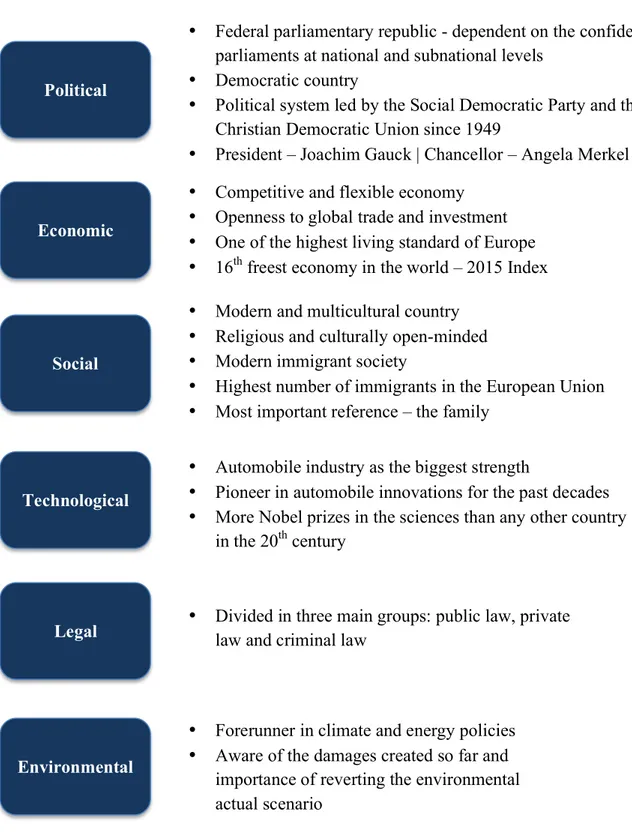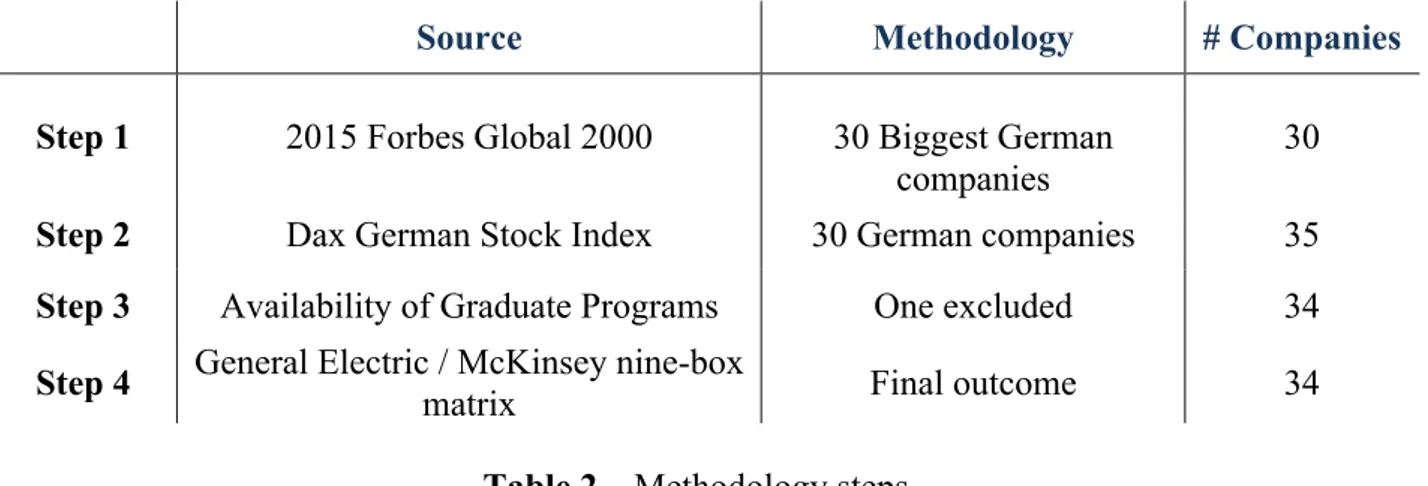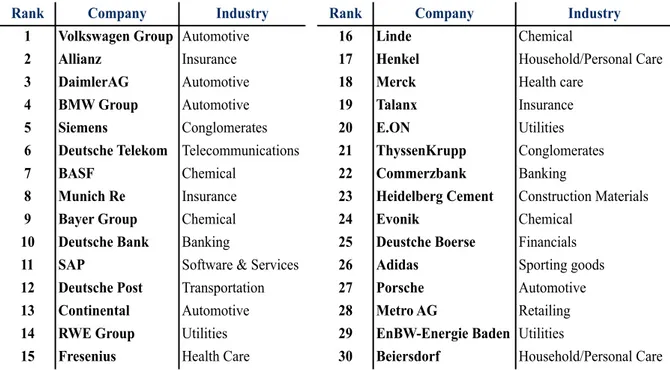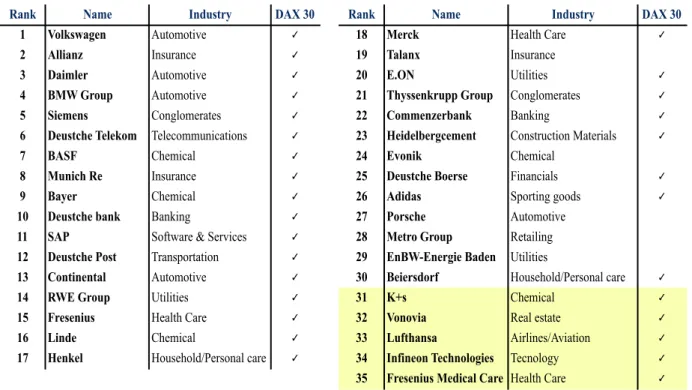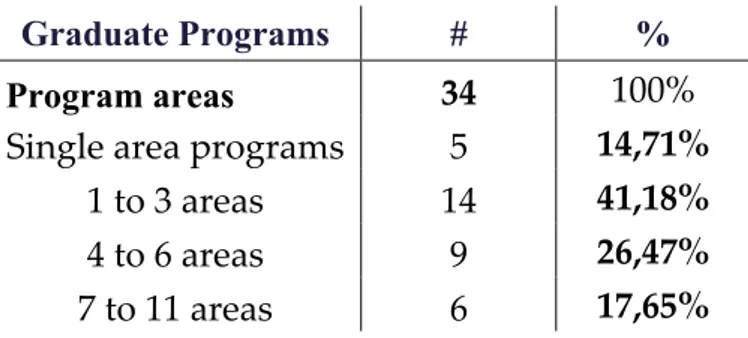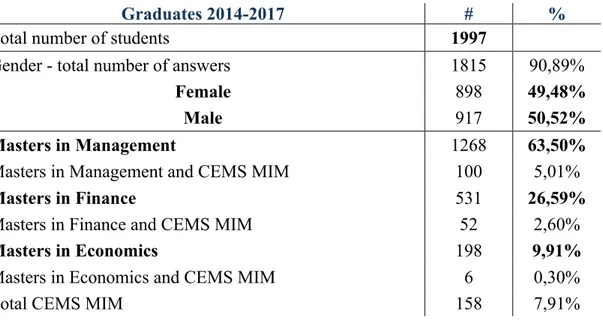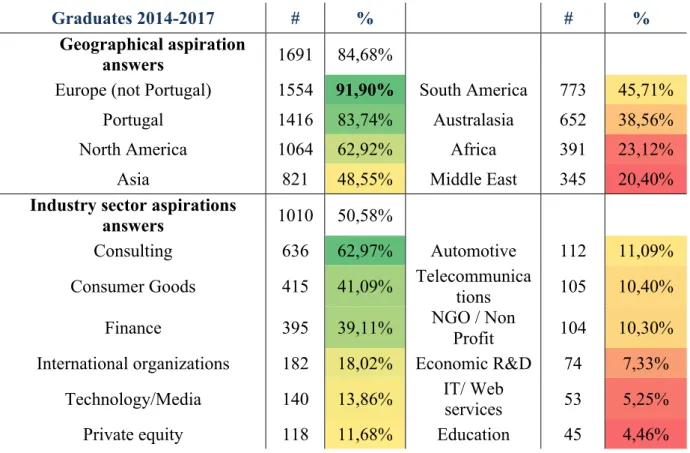Management from the NOVA – School of Business and Economics.
International Placement
Analysis of the German business market for a Nova School of Business and
Economics graduate student
Constança Maria Leitão Piló Líbano Monteiro Student number 2229
A Project carried out on the Master in Management Program, under the supervision of Professor Sara Alves
TABLE OF CONTENT
ABSTRACT ... 2
CONTEXT ... 2
INTERNATIONAL PLACEMENT ... 2
NOVA SCHOOL OF BUSINESS AND ECONOMICS ... 4
ANALYSIS OF THE GERMAN MARKET ... 6
METHODOLOGY ... 8
GRADUATE PROGRAMS ... 11
A NOVASBE MASTERS STUDENT ... 15
GENERAL ELECTRIC / MCKINSEY NINE-‐BOX MATRIX ... 18
CRITERIA ... 19
WEIGHTS ... 21
GRADES ... 22
STRATEGY AND SUGGESTIONS ... 24
REFERENCES ... 26
Abstract
Changes in today’s society led to the evolution of professional migrations and individual searches for more suitable professional opportunities and careers outside one’s countries. International Placement is nowadays one of the world’s biggest trends in higher education for the future ahead and an appealing demand of the Millennium generations. The following work project aims to study the German business market identifying the most attractive German companies and respective graduate programs for a Nova School of Business and Economics graduate student. The study’s conclusion relies on concrete strategic suggestions regarding the implementation of the results and practical use of the outcome provided.
International Placement | Graduate students | German business market | Nova SBE
Context
International Placement
The present work project relies on the professional and social movement frequently seen nowadays known as International Placement, more precisely in the study of the German business market for a Graduate student of Nova School of Business and Economics (referred in the following study as Nova SBE).
facts became clear: that International Placement and the movement of searching for better professional conditions outside one’s own country is definitely becoming a bigger reality in today’s society: many factors can be pointed out to justify this evidence, such as the increase of communication facilities and ease of sharing information that gave awareness to all different companies and programs, among many other aspects, that will be further analyze. The second evidence is that International Placement isn’t yet a common expression among the professional environment as much as it should be in the year 2015: one curious aspect that appeared from my research is the lack of documents and online sources relating to the specific expression of International Placement as an educational and professional reality. As an interesting example I point out the non-existence of a web page referring to International Placement in one of the world’s largest online encyclopedias - Wikipedia. This fact is only relevant for the knowledge that the International Placement movement and educational strategy is yet a technique to be adequately explored and studied.
country. Alongside with the decrease of jobs available (due to the higher demand from graduate students), a much more aggressive competitiveness between recent graduates came into the picture. Only one generation ago, any student with a high education degree would have a suitable place for him to work in Portugal that was adequate to his or her abilities and professional ambitions. Nowadays, things are no longer like that. Consequently, young professionals started to accept the reality that surrounded them and started looking for international job positions aiming for better working conditions and jobs more suitable to their abilities. Therefore, the presented theme is not only a valuable asset for our school as the ability to place our students more accurately outside Portugal’s barriers but also a clear necessity of all men and women aiming to enter the professional market in 2015.
Nova School of Business and Economics
recognition. Nova SBE University has strived for more than 30 years to accomplish a position in the Portuguese market that is capable of serving the surrounding market and benchmarking international standards and school practices. The specific strategic vision of placing itself among the best schools in Europe was the way to fulfill the greatest ambition and identified vocation of preparing its students to compete with graduates from international schools all over the European market. Furthermore, it was seen as a path to overcome the predicaments of Portugal’s regional, cultural and economic confinement – “located at the south-west tip of Europe, landlocked from continental Europe by a powerful and aggressive neighbor and relatively poor.”iv The faculty’s vision is to place its strategic goals before every decision or every step towards the future. The will to be in the top 10 European Schools must have implications at many school levels like the recruitment processes, the student admissions, the development of the program offered as well as the course content and essentially the support and placement of all its students.Presently, the School is at an “export model” phase, whose aim is to compete in the market of “tradable” students, in other words, internationally mobile national and international students. At the current stage, the University states as the critical factors for achieving and building a reputable brand the followingv:
• Presence in the Financial Times (top 30) rankings – #28 in Europe in 2015 • An increase in the output of scientific research of an international standing • Achieving the Triple Crown
• International recruitment and placement of Masters students – present work project • The start of executive education activities in Angola
the European Space in the high educational world.vi All of these factors led Nova University to be able and desiring to attract more and more international students and to aspirate to a highlight position in the European ranking of the greatest business schools. The success in the recruiting of foreign students in Nova SBE Masters program gave the school a higher responsibility in what concerns their most suitable placement.
Analysis of the German market
In the following chapter the targeted market of the presented work project – the German market - will be analyzed and the most relevant aspects highlighted to provide the necessary perspective and knowledge of the work to come. The selection of the German market over all other countries has its own credibility based on the business attractiveness of this European country and its particular growth over the past years as well as the high degree of notoriety that Nova SBE has gained among German students judging from the increasingly number of Masters students coming from Germany every year.
In order to deeply analyze the German market and to track the environment where the selected German companies operate in a PESTLE Analysis was made.vii
largest economy in the world by Gross Domestic product and 1st in Europe. It is also the 5th world largest country by purchasing power parity and was also a founding member of the European Community in 1957, which became the European Union in 1993.
Table 1 – Germany PESTLE analysis. (For extended analysis go to Appendix 1) Political
Economic
Social
Technological
Legal
Environmental
• Federal parliamentary republic - dependent on the confidence of parliaments at national and subnational levels
• Democratic country
• Political system led by the Social Democratic Party and the Christian Democratic Union since 1949
• President – Joachim Gauck | Chancellor – Angela Merkel
• Competitive and flexible economy
• Openness to global trade and investment
• One of the highest living standard of Europe
• 16th freest economy in the world – 2015 Index
• Modern and multicultural country
• Religious and culturally open-minded
• Modern immigrant society
• Highest number of immigrants in the European Union
• Most important reference – the family
• Automobile industry as the biggest strength
• Pioneer in automobile innovations for the past decades
• More Nobel prizes in the sciences than any other country in the 20th century
• Divided in three main groups: public law, private law and criminal law
• Forerunner in climate and energy policies
Methodology
The present chapter aims to identify a work methodology capable of selecting the best German companies for a graduate student of Nova University. The question to be answered relied on the identification of the best market search methodology to highlight the best companies. The decision was made to select the biggest and most promising companies based in Germany: the choice was made upon the statistic reality that most Nova graduates haven’t yet had a professional experience of any kind until the time of their graduation and for this reason, the knowledge that they have of their favorite industries or sectors appears to be limited and not accurately grounded. Another possible criteria were the selection of the best companies by sectors around Germany, but since it was proven more attractive to Nova students to begin their careers in a big and well-known company a different methodology was adopted. The presented methodology was introduced and explored by four different steps:
Table 2 – Methodology steps
Step 1 | The first criterion used to identify and select the pool of German companies was the Forbes Global 2000 rank. The ranking selects and places the world’s 2000 biggest companies based on four distinct metrics: the amount of sales collected in the year in discussion; the value of the company’s profits; the company’s assets value; and the company’s actual market value. It is a reference ranking that aggregates four of the most important metrics when analyzing and comparing companies alike. The four Key Performance Indicators are first
Source Methodology # Companies
Step 1 2015 Forbes Global 2000 30 Biggest German
companies
30
Step 2 Dax German Stock Index 30 German companies 35
Step 3 Availability of Graduate Programs One excluded 34
Step 4 General Electric / McKinsey nine-box
listed on separate lists of the “2000 biggest companies” in each of the metrics: Sales 2000, Profits 2000, Assets 2000, and Market value 2000. Every list has a minimum cutoff value that must be respected in order for a company to qualify.x After that, every company receives a separate score for each metric based on where it ranks on the metric’s 2000 list. If a company ranks below any metric’s 2000 list cutoff, it receives a zero score for that metric assuring a high standard of results for every company. Furthermore, the scores are added up for all four metrics (equally weighted) and compile a composite score for each company based on their rankings. All the companies are sorted in descending order by the highest composite score. The highest composite score gets the highest rank. Since the chosen market is the German one, the 30 biggest German companies were selected and ranked as shown below.
Table 3 – 30 Biggest German companies | Forbes Global 2000
Step 2 | The Deutscher Aktienindex is a blue chip stock market index consisting of the 30 major German companies trading on the Frankfurt Stock Exchange. DAX German stock index measures the performance of the Prime Standard’s 30 largest German companies in terms of order book volume and market capitalization.xi It was considered relevant in the present work to rank and quantify better each company performance in the overall German
Rank Company Industry Rank Company Industry
1 Volkswagen Group Automotive 16 Linde Chemical
2 Allianz Insurance 17 Henkel Household/Personal Care
3 DaimlerAG Automotive 18 Merck Health care
4 BMW Group Automotive 19 Talanx Insurance
5 Siemens Conglomerates 20 E.ON Utilities
6 Deutsche Telekom Telecommunications 21 ThyssenKrupp Conglomerates
7 BASF Chemical 22 Commerzbank Banking
8 Munich Re Insurance 23 Heidelberg Cement Construction Materials
9 Bayer Group Chemical 24 Evonik Chemical
10 Deutsche Bank Banking 25 Deustche Boerse Financials
11 SAP Software & Services 26 Adidas Sporting goods
12 Deutsche Post Transportation 27 Porsche Automotive
13 Continental Automotive 28 Metro AG Retailing
14 RWE Group Utilities 29 EnBW-Energie Baden Utilities
market. With the new metric chosen, the DAX 30 list was added to the previous Forbes 30 companies. By matching all of them, 5 new companies appeared and are now in the 35 list of the best German companies to analyze.
Table 4 – 35 Greatest German companies according to Forbes and Dax Index
Step 3 | The following step was to identify which companies had a graduate program available for graduate students. From de 35 list of the best German companies to analyze only 1, Vonovia, didn’t have a graduate program and was excluded from the study.
Step 4 | The fourth and final step was the composing of the General Electric / McKinsey nine-box matrix revealing the most attractive graduate programs and at the same time the degree of competitiveness of Nova students for that same program. The attractiveness level was defined by the companies’ location, international perspective of the programs, number of different areas approached during the program and remuneration level. The competitiveness of the students’ pool was defined by the knowledge of the German language, the ability to speak a second language (aside from English) and the grades level.
Rank Name Industry DAX 30 Rank Name Industry DAX 30
1 Volkswagen Automotive ✓ 18 Merck Health Care ✓
2 Allianz Insurance ✓ 19 Talanx Insurance
3 Daimler Automotive ✓ 20 E.ON Utilities ✓
4 BMW Group Automotive ✓ 21 Thyssenkrupp Group Conglomerates ✓
5 Siemens Conglomerates ✓ 22 Commenzerbank Banking ✓
6 Deustche Telekom Telecommunications ✓ 23 Heidelbergcement Construction Materials ✓
7 BASF Chemical ✓ 24 Evonik Chemical
8 Munich Re Insurance ✓ 25 Deustche Boerse Financials ✓
9 Bayer Chemical ✓ 26 Adidas Sporting goods ✓
10 Deustche bank Banking ✓ 27 Porsche Automotive
11 SAP Software & Services ✓ 28 Metro Group Retailing
12 Deustche Post Transportation ✓ 29 EnBW-Energie Baden Utilities
13 Continental Automotive ✓ 30 Beiersdorf Household/Personal care ✓
14 RWE Group Utilities ✓ 31 K+s Chemical ✓
15 Fresenius Health Care ✓ 32 Vonovia Real estate ✓
16 Linde Chemical ✓ 33 Lufthansa Airlines/Aviation ✓
17 Henkel Household/Personal care ✓ 34 Infineon Technologies Tecnology ✓
Graduate Programs
The following analysis will rely upon the Graduate Programs available at the 34 selected German companies and in its main characteristics. An online research was made mainly in the companies’ web pages and specific career pages. No additional information was added to the results (like German students’ knowledge and opinion of the company to be analyzed) in order to reflect exactly the information companies purposely release to the students and reflect a 100% unbiased research. At the same time resorting to the online company’s websites was the most accurate way to guarantee the most updated information source of all. The majority of the information and guidelines released by the companies was very similar to every one of them in type and format. The most common features mentioned were the
language requirements; the application method, duration and important deadlines of the programs; features for the required profile of the candidates that include, grade levels, previous professional and international experience, readiness to go abroad and academic degree and area of study; and finally the main areas undertaken by the program such as Marketing and Sales, Finance or Logistics. The structure was always divided in program features information and profile requirements.
Location | The first information gathered from the companies was the location of their headquarters. Since the research aims to attract the best companies in the students’ perspective the city where the graduate programs would take place was of high importance. Cities were gathered according to the urbanization degrees and divided into three distinct groups that will be further explained.
the companies say that English language is mandatory. However, in the present analysis the English language as mandatory will not be considered a constraint since 100% of Nova’s masters’ students have studied and graduated from an English language master program (at least) and so it can be assumed that all of them dominate the English language.
Graduate Programs # %
German language 14 41,18%
Mandatory 9 26,47%
Beneficial 5 14,71%
Table 5 – Graduate Program language requirements
months – between 19 and 20 months. Common to all of the three features there was in some cases the option of an “on going” process, with no specific dates or schedules.
The last feature presented by the companies is their program field areas, where the program will have a higher focus. One interesting thing was that many companies have many different graduate programs in separately specific areas (like Finance or Marketing) instead of one global program with a rotating position process as is normally seen in Portugal. Besides that the other graduate programs showed a great diversity and variety of programs covered, the most popular ones being the Sales department, Marketing, Finance, Human resources, Operations and Logistics, IT and Business development and Strategy. The average number of programs covered by the programs is 5,27, which is a very attractive number for students about to have their first professional experience, like almost every Nova’s master student.
Graduate Programs # %
Program areas 34 100%
Single area programs 5 14,71% 1 to 3 areas 14 41,18% 4 to 6 areas 9 26,47% 7 to 11 areas 6 17,65%
Table 6 – Graduate Program language requirements
finally two of them say that the maximum period of time a candidate should have been working is around one year time. Another very important aspect of any student graduating in the 21st century is the international experience they have. A relevant experience abroad, such as a semester studying outside your own country, working or traveling around the world, constitutes an almost mandatory characteristic of your academic years and life experience nowadays. From the data collected, almost 50% of all companies (sixteen) state that an international experience is a mandatory feature to be characterized as a proper applicant: four of them even say that the experience should have a minimum time period comprehended between four to twelve months of extension. None of the companies state a maximum time for the abroad experiences. Fourteen out of the thirty-four companies answer another topic regarding the readiness for international career and international assignments while in the graduate program. They all say students must be ready to go abroad if wanting to become suitable for the job position. The specified time of the assignments varies between three to six months traveling and working somewhere in the world.
Regarding the final grades, a general concern of all students during their time studying, thirteen out of thirty-four companies specify some standard to the candidate grades.
Graduate Programs # %
Grades 13 100%
Excellent 5 38,46%
Above average 8 61,54%
Table 7 – Graduate Program grades requirements
A NOVASBE masters student
The following chapter of my dissertation relies on the profile of a Nova Masters student, the precise target population of this study. The presented analysis was based on information from the school online data source, Simplicity. It is important to highlight that the sample of the analysis cannot guarantee 100% veracity, since it is impossible to ensure that all students have made their personal login at the online platform or that all of the information introduced is entirely true. However, it is the most accurate information source available at the moment. The survey presented to the students was in a close answer model with limited possible options. Information from students graduating between the year 2014 and 2017 (last class entering the masters programs) was taken into consideration in order to provide a wide range of different classes and years and to standardize the student’s actual profile. The three masters programs available at Nova University and represented in the study are the Masters in Management, Masters in Finance and Masters in Economics. At the same time, some of these students are CEMS MIM alumni.
This chapter purpose is to characterize those exact students throughout a diversity of topics provided. They are: the student gender; nationality; the finalGPA of their masters program (or current GPA in 2016 classes); each student geographical, industry sector and job area aspirations; experience in internationalmobility; language proficiencies and geographical expertise; and finally information on their undergraduate programs.
Table 8 – Total number of students, Gender and type of Masters program
International students and languages | The number of international students has been increasing exponentially over the years. The average percentage of all four years in discussion is 33,15%. However, this year, within the 2017 graduating class, the percentage of international students reached 42,42%. The University masters program already counts with students from all over the world, as for example Albania, Azerbaijani, Serbia, New Zealand, Moldavia, Latvian, Kazakhstani, Israeli and Kenya. Among the innumerous nationalities (aside from Portuguese), most students come from Europe. The numbers related to the German population attending the Nova masters (42,15%) heavily support the attractiveness of the German market as a country of placement for our school and students.
Graduates 2014-2017 # %
Average number of International students per year 662 33,15%
German 279 42,15%
Italian 115 17,37%
Polish 16 2,42%
Average number of languages spoken 2,705 -
Languages - total number of answers 1692 84,73%
German-speaking students 342 20,21%
Students speaking more than 2 languages 885 52,30%
Table 9 – International students, and languages spoken
Graduates 2014-2017 # %
Total number of students 1997
Gender - total number of answers 1815 90,89%
Female 898 49,48%
Male 917 50,52%
Masters in Management 1268 63,50%
Masters in Management and CEMS MIM 100 5,01%
Masters in Finance 531 26,59%
Masters in Finance and CEMS MIM 52 2,60%
Masters in Economics 198 9,91%
Masters in Economics and CEMS MIM 6 0,30%
GPA | The grades at Nova SBE are in a 0 to 20 scale.
Table 10 – Student’s grades, average grade and above average students
Geographical and industry sector aspirations | The numbers were clear and 91,90% said they would want to work in Europe (not Portugal), making once again the German market a reality in the most attractive markets for Nova’s students. Only half of the students answered this question which makes its accuracy a little less precise and leaving some space for a higher deviance of results. However, 62,97% of the students that answered this question said they would aspire to work in consulting where 74,21% of those specified the consulting type area in a management/strategic area and 34,59% in financial services consulting.
Graduates 2014-2017 # % Column1 #2 %2
Geographical aspiration
answers 1691 84,68%
Europe (not Portugal) 1554 91,90% South America 773 45,71%
Portugal 1416 83,74% Australasia 652 38,56%
North America 1064 62,92% Africa 391 23,12%
Asia 821 48,55% Middle East 345 20,40%
Industry sector aspirations
answers 1010 50,58%
Consulting 636 62,97% Automotive 112 11,09%
Consumer Goods 415 41,09% Telecommunica
tions 105 10,40%
Finance 395 39,11% NGO / Non
Profit 104 10,30%
International organizations 182 18,02% Economic R&D 74 7,33%
Technology/Media 140 13,86% IT/ Web
services 53 5,25%
Private equity 118 11,68% Education 45 4,46%
Table 11 – Student’s geographical and industry sector aspirations
Graduates 2014-2017 # %
Grades - total number of answers 1273 63,75%
Average grade 15,64 -
International mobility and background | These international mobility experiences can be either from the CEMS MIM semester abroad, some exchange period or from a double degree format that invites students to study an entire year in a different country from Portugal. The value presented allows us to believe that students really want to expand their horizons and professional experience abroad by searching for an international placement strategy. This factor ensures once more the relevance of this theme and a certainly very practical use for the school especially for the students. The diversity of backgrounds shows Nova’s effort to guarantee that students without any management background could also enter the program if proven to have high quality degrees in other different areas.
Table 12 – Student’s international mobility during the masters program and background
General Electric / McKinsey nine-box matrix
The following chapter relies on the theoretical and practical use of the General Electric / McKinsey nine-box matrix. The chosen framework appeared in the early 1970s and was conceived to support the process of analyzing different business portfolios of a company Business strategy unit (BSU). The final purpose of the GE / Mckinsey matrix is to identify the optimal business portfolio for a selected company. This optimal portfolio is one based on the company’s relative business strengths and at the same time the one exploring the most attractive sectors or markets where the company performs. The main goals of the present framework are to analyze the actual business portfolio of specific company and decide which
Graduates 2014-2017 # %
International mobility during the Masters 556 27,84%
Undergraduate programs - answers 1660 83,12%
Management, Administration, Economics or Finance 1402 84,46%
BSU should receive more or less investment; to develop growing strategies; and to decide which businesses should not go on. The purpose analysis suggest that: for units above the diagonal, a company may pursue strategies of investment and growth; those along the diagonal may be candidates for selective investment; and for those below the diagonal might be best to be sold, liquidated, or run purely for cash. In the present work project I will be analyzing the attractiveness of the different graduate programs and the competitiveness of Nova students in those exact same programs with the help of the nine-box matrix.
Criteria
The first step behind the preparation of the matrix is to identify the criteria by which the Graduate Programs will be analyzed as well as the criteria by which Nova students will be classified as a competitive pool of candidates or not. The process to evaluate Nova students as competitive or not relied on the percentage of students that may be accepted as a candidate for each program regarding three specific measures: if they speak German, if they speak at least two different languages (English and another one) and if they have a grade level that meets the one required (for complete information see Table 7, Appendix 4). Moreover, after gathering all the information companies give on their programs (Chapter 4 – Graduate programs), four criteria stood out for their relevance upon their attractiveness level.
counts with cities like Bonn, Heidelberg, Kassel and Walldorf among others. xii (Complete table presented in Appendix 2)
Program areas | The second evident criteria are the number of different program areas students will have the opportunity to deepen in each graduate program. Two main types of programs were immediately identified: the first type being the one area specific graduate programs, in other words, a program that will only approach one area (like Finance or Marketing) and the second type being the real trainee programs that aim to give the candidate a broader view of the company, having rotating positions in different areas from Logistics to Sales to Strategy or even Controlling. The programs were ranked accordingly with the recent survey “Are you Ready?” conducted by Nova to this year’s class of Masters students (detailed results from the study in Appendix 3). The survey asked the students how they valued some specific opportunities in their first work experience. From 367 answers the opportunity with the higher result was “Learning opportunity” scoring 3,77 in average out of 4. Therefore, we can assume that the most attractive programs are the ones that offer a bigger variety of business areas. The least attractive ones are those that have few areas of approach. Again, three groups were made based on their attractiveness level.
Program areas
Group 1 11 to 7 areas
Group 2 6 to 4 areas
Group 3 < 3 and single area programs
Table 13 – Graduate program areas groups
International perspective | The third criterion relies on the existence of an international perspective within the graduate programs. As mentioned before in Chapter 4 – Graduate Programs, some companies demand their candidate’s readiness to go abroad due to the existence of international assignments in their programs. Also from the latest survey conducted by Nova masters office, students answered that they valued 3,22 out of 4 the opportunity to have international exposure in their first job position. Consequently, programs with international exposure were perceived as more attractive than the ones not having it.
Remuneration | The fourth and final criterion is the remuneration associated with each company. No information was available regarding the compensation package of a graduate in the thirty-four graduate programs. However, the remuneration attributed to a Praktikant (Intern) is known for almost all companies in the study. Despite of the fact that the relation between the Intern’s salary and a graduate one in every company is not 100% accurate, the information was taken into account in order to rank the companies and divide them in groups according to their payment levels. The aim is not to extract which companies will pay more for a graduate position but to retain an average view of how attractive are the payments inside the different companies. Three groups were divided according to salary payments values:
Remuneration
Group 1 ≥ 1000€
Group 2 900€≥ 999€
Group 3 700€≥ 899€
Table 14 – Graduate programs remuneration groups Weights
again according to the “Are you ready?” survey, since it is the most accurate and recent information Nova can work with. The question posed was ‘On my first work experience I value…’ and the scale was from 1 to 4, being 1 ‘Not important at all’ and 4 ‘Very important’.
Learning opportunity 3,77
Career progression 3,51
International exposure 3,22
Recognized status (work for a well-known company) 3,02
Work-life balance 3,00
Remuneration 2,81
Stability 2,68
Table 15 – Students valorizations of first work experiences features – ‘Are you ready?’ survey results
Accordingly to these results the weights were attributed and in an attractiveness order they are now: Program areas with 35%, International perspective with 30%, Location with 20% and Remuneration with 15%.
Grades
The third and final phase relates to the grades. The grades were attributed accordingly to the GE/McKinsey criteria that divide the level of attractiveness in: High (from 7 to 10), Medium (from 4 to 7) and Low (from 1 to 4).
Company A
Groups Location - 0,2 Grades Groups Int. perspective - 0,3 Grades
Group 1 Urban centers with more than 600k
habitants (5) 10 Group 1 Yes 10
Group 2 Urban centers with 400k up to 600k
habitants (5) 7 Group 2 - -
Group 3 Urban centers with less than 400k
habitants 4 Group 3 No 4
Program areas - 0,35 Remuneration - 0,15
Group 1 11 to 7 areas 10 Group 1 ≥ 1000€ 10
Group 2 6 to 4 areas 7 Group 2 900€≥ 999€ 7
Group 3 Less than 4 areas and single area
program 4 Group 3 700€≥ 899€ 4
The companies were evaluated and the final outcome is presented in the Matrix graphic:
Table 17 – GE / McKinsey nine-box Matrix of the selected German companies (Further information regarding the Matrix in Appendix 4)
Regarding the analysis of the final result there are a few important aspects to highlight:
•
The main features that make a company rely into a 25% or below competitive level is the demand for German and the excellent grades requirement.•
The main features that make a program less attractive are the non-existence of international exposure and the lack of different areas of approaching.•
There are sixteen companies out of the thirty-four demanding for German language.100% 4 7 10
50% 25% 0%
Strategy and Suggestions
The final chapter of my work project is intended to identify the Top 3 Best companies for a Nova graduate student and to state the strategic moves for the next phase of Placement. It will be divided into two distinct branches: the strategy and consequential suggestions.
Strategy | The Top 3 companies rated at the highest level are: Adidas, Linde and Beisendorf. The three companies have a rate of 100% in what concerns the competitiveness of the students, which means that every masters student studying at Nova constitutes a valid candidate for each program, and a 6,7 or higher grade of attractiveness of the program, the highest grades of all. The strategy related with the absorption and implementation of the final outcome is directed to Nova SBE’s educational work force and relies upon three main topics:
1. Direct contact with the companies | This step is the most important one and must be carried out by Nova. The aim is to start building bridges and creating relationships in order to show them the Nova students as promising candidates for their programs.
2. Creating awareness among the students | To increase the attractiveness of the international Placement strategy undertaken by the University students must be aware of the different opportunities in the appropriate companies per country or market.
3. Prepare the students and make them more competitive | The goal is to give Nova
students the best possible preparation to succeed in a foreign market like Germany.
Suggestions | The suggestions part of my work project has its own practicability due to the topic’s relevance for the University and the need to implement new approaches. Each suggestion relates to the respective previous strategy topic.
Nova masters students-company match. Instead of visiting only the best companies in Germany, we will be visiting the best companies in German for a Nova Graduate student.
2. Online platform | Set up of an online platform where students can search for job positions and learn about graduate programs in specific countries. The idea is to have a global placement platform concentrating all information regarding placement in Portugal and foreign countries. Furthermore, to maximize its usage and suitable application the platform should have a two-way function when looking for professional placement: firstly students must be able to search for a graduate program by its own particular features, like the program’s starting date, program areas or even required mandatory languages; secondly students must be able to introduce their main characteristics like master’s final grade, job industries ambitions, spoken languages and professional experience and come up with the most suitable program for them. This will allow students to broaden their search and applications and to address the most suitable program for each career ambitions.
3. International modules | Creation of modules specialized in specific markets, like the German automobile market or just an overview of the German market. The implementation of these modules aims to increase the awareness of different markets among students and give them more tools to succeed in those environments. The idea is to give students the possibility to understand more about different countries and what it would be like to work there as well as what are their main sectors of activity are.
References
i. Base de dados Portugal Contemporâneo, (2015, October 15th).
ii. Trading economics, (2015, October 15th).
Retrieved from http://www.tradingeconomics.com/portugal/retirement-age
iii. Education at a Glance 2012: OECD Indicators, (2015, October 15th). Retrieved from
http://www.oecd.org/edu/Portugal_EAG2013%20Country%20Note.pdf
iv. Nova SBE spokesman at the University site, (2015, October 28th). Retrieved from
http://www.novasbe.unl.pt/pt/2011-05-02-12-32-40/mission-and-vision
v. Nova SBE web portal, (2015, October 28th). Retrieved from
http://www.novasbe.unl.pt/pt/2011-05-02-12-32-40/mission-and-vision
vi. DGES, Direção-Geral do Ensino Superior, (2015, October 28th). Retrieved from
http://www.dges.mctes.pt/DGES/pt/Estudantes/Processo+de+Bolonha
vii. Oxford learning Lab, (2015, November 9th). Retrieved from
http://www.oxlearn.com/arg_Marketing-Resources-PESTLE---Macro-Environmental-Analysis_11_31 (PESTLE analysis is a management tool that helps assess the macro-environmental factors of a specific country or company. PESTLE is a mnemonic that in its expanded form denotes P for Political, E for Economic, S for Social, T for Technologic, L for Legal and E for the environmental characteristics and main trends of the selected market.)
viii.Worldmeters, (2015, November 9th).
Retrieved from http://www.worldometers.info/world-population/germany-population/
ix. Digital Agenda for Europe, (2015, November 9th).
Retrieved from http://ec.europa.eu/index_en.htm
x. Forbes, (2015, November 9th)
Retrieved from http://www.forbes.com/sites/andreamurphy/2015/05/06/2015-global-2000-methodology/
(For the first KPI, the sales value, the value presented must be higher or equal $4.16 billion; regarding the profits the minimum value required is $267.0 million; for the company’s assets $8.57 billion and their market value should be higher or equal to $5.49 billion. Furthermore, a company only needs to qualify for one of the lists in order to be eligible for the final Global 2000 ranking.)
